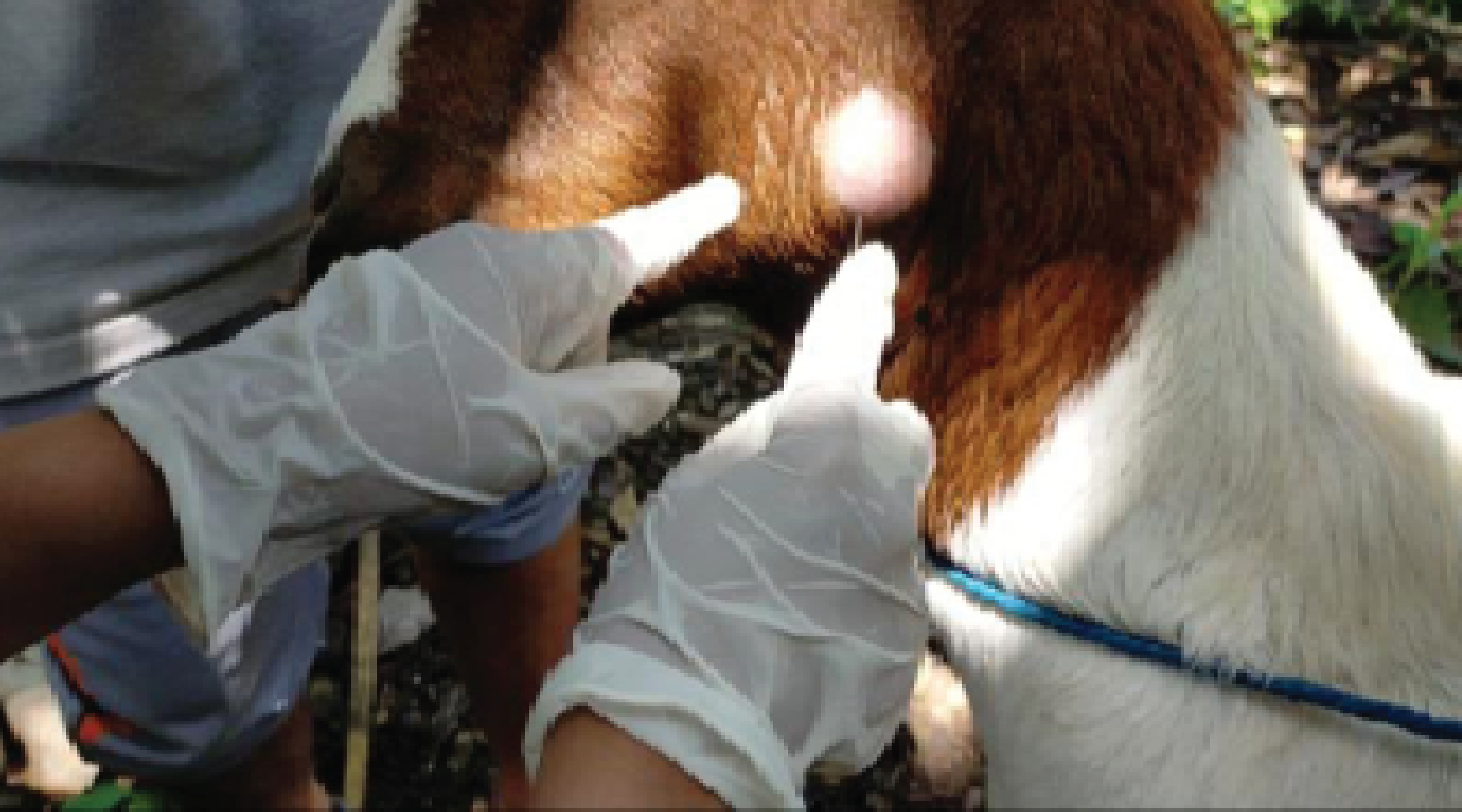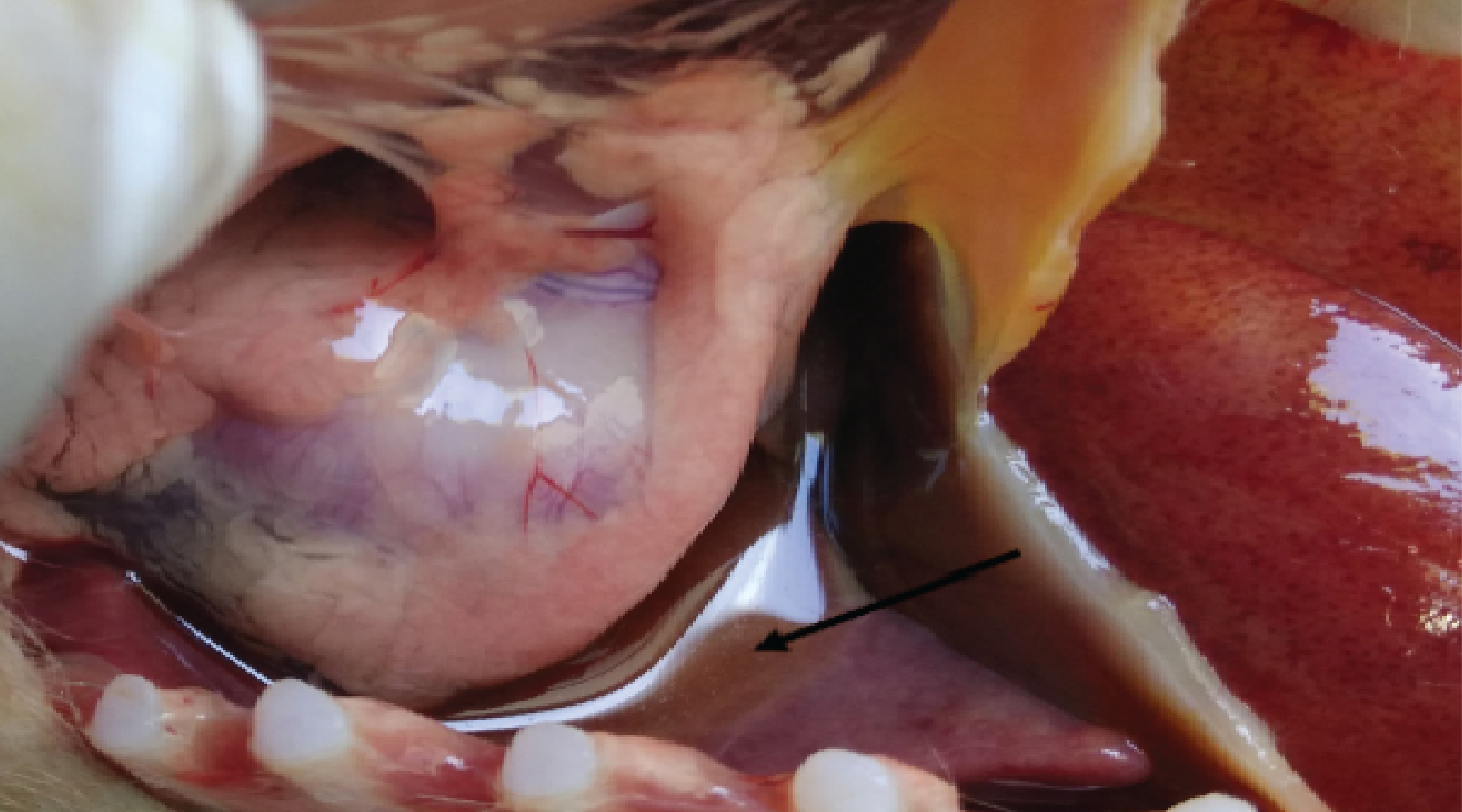Isolation and Molecular Identification of Fungal Contamination on the Eggshells of Lepidochelys olivacea L. Collected from Coastal Waters

Background: One of the causes of the decline in the Olive ridley turtle population is the low egg hatching rate due to contamination by pathogenic fungi. Purpose: This study aims to evaluate the results of the isolation and molecular identification of fungal contamination on the eggshells of olive ridley turtles that failed to hatch from three coastal waters in Bali province. Method: Sampling was done using the purposive sampling technique. Samples of failed hatching eggshells from the coast were collected, as many as 2 eggs/semi-natural nest at TCEC. Samples were cultured on PDA media. Macroscopic and molecular identification methods were carried out to determine the species level of fungal isolates. Results: The results showed that 10 fungal isolates were successfully collected. Isolates KL1 and SG1 had white colony surface characteristics, isolates KL4, SY2 and SY3 showed black colonies, and isolates KL2, KL3, SG2, SG3, SY4 had green colonies. Three similar isolates were sent for further molecular identification. The BLASTn results of the nucleotide sequences of isolates SY2 and SG3 showed a similarity to Aspergillus niger strain PHY105 (91%), while fungal isolate KL1 had a similarity to Fusarium solani strain 87, by 98%. Conclusion: This study provides new information about the pathogenic fungi, Fusarium solani strain 87 and Aspergillus niger strain PHY105, which are suspected to be the cause of the hatching failure of olive ridley turtle eggs.
Afriani, A. and Heviyanti, M., 2018. Karakteristik Jamur Fusarium oxysporum f.sp.cepae Penyebab Penyakit Busuk Umbi pada Bawang Merah (Allium ascalonicum). Prosiding of Seminar Nasional Pertanian dan Perikanan, 1, 70–74.
Ayuningtyas, I., Kushartono, E.W., and Redjeki, S., 2019. The Identification of Fungi in Lepidochelys olivacea, Eschscholtz, 1829 (Reptilia: Cheloniidae) at the Turtle Conservation and Education Center in Bali. Journal of Marine Research, 8(2), 157–167.
Azzahra, F., Arefadil Almalik, E., and Atkha Sari, A., 2019. Uji Aktivitas Antibakteri Dari Ekstrak Etanol Daun Alpukat (Persea Americana Mill.) Terhadap Bakteri Salmonella Typhi Dan Staphylococcus Aureus. Jurnal Kefarmasian Akfarindo, 1–10.
Bahri, S., Madduppa, H.H., and Atmadipoera, A.S., 2023. Keragaman Genetik Penyu Lekang (Lepidochelys olivacea) dan Kaitannya Dengan Pola Arus di Perairan Samudera Hindia dan Perairan Tengah Indonesia. Journal of Marine and Aquatic Sciences, 8 (2), 254-266.
Blasi, M.F., Migliore, L., Mattei, D., Rotini, A., Thaller, M.C., and Alduina, R., 2020. Antibiotic Resistance of Gram-Negative Bacteria from Wild Captured Loggerhead Sea Turtles. Antibiotics, 9(4), 1-11.
Dallas, J.W. and Warne, R.W., 2023. Captivity and Animal Microbiomes: Potential Roles of Microbiota for Influencing Animal Conservation. Microbial Ecology, 85 (3), 820–838.
Ebani, V.V., 2023. Bacterial Infections in Sea Turtles. Veterinary Sciences, 10 (5), 1-19.
El-Naggar, N.E.A., Haroun, S.A., El-Weshy, E.M., Metwally, E.A., and Sherief, A.A., 2019. Mathematical Modeling for Bioprocess Optimization of E Protein Drug, Uricase, Production by Aspergillus welwitschiae strain 1–4. Scientific Reports, 9(1), 1–15.
Elita, N., Susila, E., Agustamar, A., and Rizki, R., 2022. Identifikasi Molekuler Trichoderma spp. Indigenous dari Rizosfer Beberapa Varietas Padi Asal Kabupaten Lima Puluh Kota dan Kota Payakumbuh. Agroteknika, 5(1), 1–13.
Fang, W., Wu, J., Cheng, M., Zhu, X., Du, M., Chen, C., Liao, W., Zhi, K., and Pan, W., 2023. Diagnosis of invasive fungal infections: challenges and recent developments. Journal of Biomedical Science, 30(1), 1-35.
Gleason, F. H., Allerstorfer, M., and Lilje, O., 2020. Newly emerging diseases of marine turtles, especially sea turtle egg fusariosis (SEFT), caused by species in the Fusarium solani complex (FSSC). Mycology, 11(3), 184–194.
Habisukan, H.,U., Elfita, E., Widjajanti, H., Setiawan, A., & Kurniawati, A. R., 2021. Diversity of Endophytic Fungi in Syzygium aqueum. Biodiversitas Journal of Biological Diversity, 22(3), 1129-1137.
Hermansyah, H., Sutami, N., and Miksusanti, M., 2018. Amplifikasi Pcr Domain D1/D2 28s Rdna Menggunakan Primer ITS1 dan ITS4 Sampel DNA dari Candida tropicalis yang diisolasi dengan Metode Pendinginan. Indonesian Journal of Pure and Applied Chemistry, 1 (1), 1-9.
Izzatinnisa’, I., Utami, U., and Mujahidin, A., 2020. Uji Antagonisme Beberapa Fungi Endofit pada Tanaman Kentang terhadap Fusarium oxysporum secara in vitro. Jurnal Riset Biologi dan Aplikasinya, 2 (1), 1-8.
Martínez-Ríos, M., Martín-Torrijos, L., and Diéguez-Uribeondo, J., 2022. The Invasive Alien Red-eared Slider turtle, Trachemys scripta, as a Carrier of STEF-disease Pathogens. Fungal Biology, 126(2), 113–121.
Mazaris, A.D., Dimitriadis, C., Papazekou, M., Schofield, G., Doxa, A., Chatzimentor, A., Turkozan, O., Katsanevakis, S., Lioliou, A., Abalo-Morla, S., Aksissou, M., Arcangeli, A., Attard, V., El Hili, H.A., Atzori, F., Belda, E.J., Ben Nakhla, L., Berbash, A.A., Bjorndal, K.A., Broderick, A.C., Camiñas, J.A., Candan, O., Cardona, L., Cetkovic, I., Dakik, N., de Lucia, G.A., Dimitrakopoulos, P.G., Diryaq, S., Favilli, C., Fortuna, C.M., Fuller, W.J., Gallon, S., Hamza, A., Jribi, I., Ben Ismail, M., Kamarianakis, Y., Kaska, Y., Korro, K., Koutsoubas, D., Lauriano, G., Lazar, B., March, D., Marco, A., Minotou, C., Monsinjon, J.R., Naguib, N.M., Palialexis, A., Piroli, V., Sami, K., Sönmez, B., Sourbès, L., Sözbilen, D., Vandeperre, F., Vignes, P., Xanthakis, M., Köpsel, V., and Peck, M.A., 2023. Priorities for Mediterranean Marine Turtle Conservation and Management in The Face of Climate Change. Journal of Environmental Management, 339, 1-11.
Pace, A., Dipineto, L., Fioretti, A., and Hochscheid, S., 2019. Loggerhead Sea Turtles as Sentinels in The Western Mediterranean: Antibiotic Resistance and Environment-related Modifications of Gram-negative Bacteria. Marine Pollution Bulletin, 149, 1-9.
Praja, R.N., Yudhana, A., and Haditanojo, W., 2018. Isolation And Identification of Fungus From Olive Ridley (Lepidochelys olivacea) Egg Shell Which Fail to Hatch in Boom Seas. Jurnal Medik Veteriner, 1(2), 11–15.
Praja, R.N., Yudhana, A., Haditanojo, W., Kusumawardani, A., Putri, A.N.J., Fadillah, I.R., Pratama, L.D., and Afiyah, N.S., 2023. A Short Note on Fusarium spp Identification from Eggs of Olive Ridley Sea Turtle (Lepidochelys olivacea) in Banyuwangi, East Java, Indonesia. Indian Veterinary Journal, 100(5), 19–22.
Risa Nursanty , Widya Sari, Safranita, R.N., W.S.S., Sari, W., and Safranita, S., 2019. Karakterisasi dan Identifikasi Bakteri Enterobacteriaceae pada Telur Penyu Lekang (Lepidochelys olivacea) asal Lhok Pante Tibang, Banda Aceh. Jurnal Sain Veteriner, 37(1), 41-48.
Sholihah, R.I., Sritamin, M., and Wijaya, I.N., 2019. Identifikasi Jamur Fusarium solani yang Berasosiasi dengan Penyakit Busuk BGatang pada Tanaman Buah Naga di Kecamatan Bangorejo, kabupaten Banyuwangi. E-Jurnal Agroekoteknologi Tropika, 8 (1), 91–102.
Šišić, A., Baćanović-Šišić, J., Al-Hatmi, A.M.S., Karlovsky, P., Ahmed, S.A., Maier, W., De Hoog, G.S., and Finckh, M.R., 2018. The ‘Forma Specialis’ Issue in Fusarium: A Case Study in Fusarium solani f. sp. pisi. Scientific Reports, 8 (1), 1–17.
Smyth, C.W., Sarmiento-Ramírez, J.M., Short, D.P.G., Diéguez-Uribeondo, J., O’Donnell, K., and Geiser, D.M., 2019. Unraveling the Ecology and Epidemiology of An Emerging Fungal Disease, Sea Turtle Egg Fusariosis (STEF). PLOS Pathogens, 15(5), 1-6.
Stanford, C.B., Iverson, J.B., Rhodin, A.G.J., Paul van Dijk, P., Mittermeier, R.A., Kuchling, G., Berry, K.H., Bertolero, A., Bjorndal, K.A., Blanck, T.E.G., Buhlmann, K.A., Burke, R.L., Congdon, J.D., Diagne, T., Edwards, T., Eisemberg, C.C., Ennen, J.R., Forero-Medina, G., Frankel, M., Fritz, U., Gallego-García, N., Georges, A., Gibbons, J.W., Gong, S., Goode, E. V., Shi, H.T., Hoang, H., Hofmeyr, M.D., Horne, B.D., Hudson, R., Juvik, J.O., Kiester, R.A., Koval, P., Le, M., Lindeman, P. V., Lovich, J.E., Luiselli, L., McCormack, T.E.M., Meyer, G.A., Páez, V.P., Platt, K., Platt, S.G., Pritchard, P.C.H., Quinn, H.R., Roosenburg, W.M., Seminoff, J.A., Shaffer, H.B., Spencer, R., Van Dyke, J.U., Vogt, R.C., and Walde, A.D., 2020. Turtles and Tortoises Are in Trouble. Current Biology, 30 (12), 721–735.
Susilowati, D.N., Indah, S., Kristina Dwi, A., and Erny, Y., 2020. Penapisan Kapang Asal Lahan Sulfat Masam Kalimantan Selatan Sebagai Penghasil Enzim Ekstraseluler. Ilmu Pertanian, 1 (21), 65–82.
Widaysari, F., Nugroho, A., Arafat, G., Sunoko, R., Wahyudin, R. A., Sayuti, M., Bakkula, E., & Ballamu, F., 2023. The first occurrence of Kemp’s Ridley turtle (Lepidochelys kempii) in Raja Ampat, Indonesia. Biodiversitas Journal of Biological Diversity, 24(9): 4934-4942.
Wiradana, P. A., Permatasari, A. A. A. P., Sari, N. K. Y., Widhiantara, I. G., Sandhika, I. M. G. S., Waruwu, E., Fimaputra, J. M., Panjaitan, N. S. D., Putri, F. R., & Ansori, A. N. M., 2024. Isolation and Molecular Identification of Endophytic Fungi Associated with Brown Algae for Inhibiting Escherichia coli ESBL. Journal of Applied Veterinary Science and Technology, 5(1), 31–41.
Copyright (c) 2024 Author(s)

This work is licensed under a Creative Commons Attribution-ShareAlike 4.0 International License.
- The journal allows the author to hold the copyright of the article without restrictions.
- The journal allows the author(s) to retain publishing rights without restrictions.
- The legal formal aspect of journal publication accessibility refers to Creative Commons Attribution Share-Alike (CC BY-SA).

Journal of Applied Veterinary Science and Technology is licensed under a Creative Commons Attribution-ShareAlike 4.0 International License





























